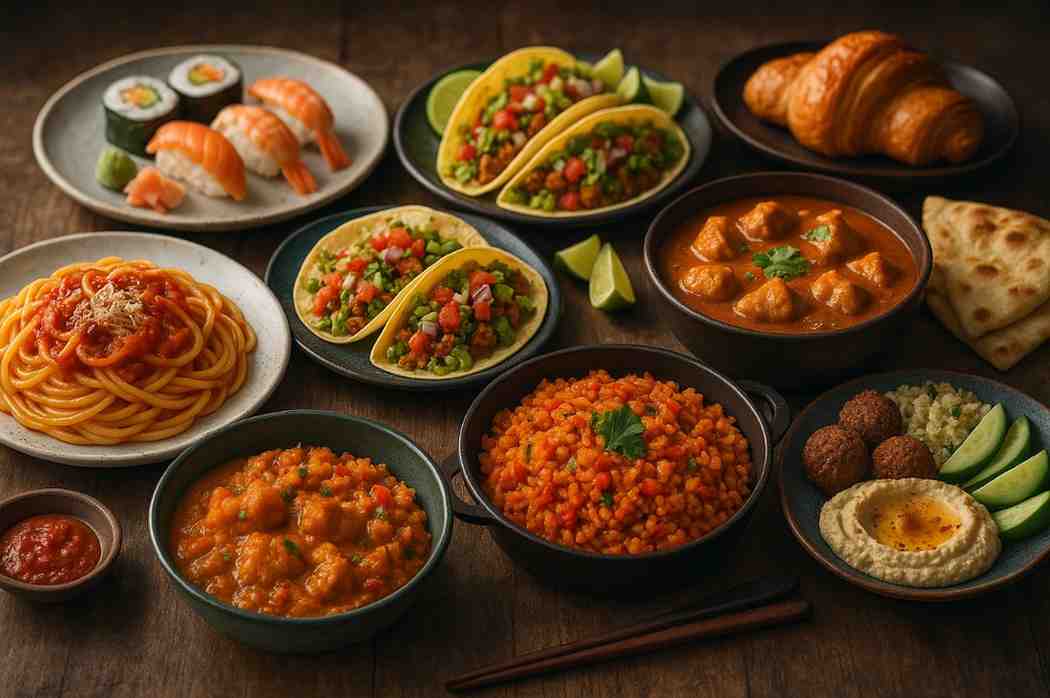
Global Cuisines: A Culinary Journey Across Continents
Food is a universal language, yet each region of the world speaks it in its own unforgettable dialect. Global cuisines are the stories of civilizations—shaped by geography, climate, trade routes, migration, and centuries of cultural evolution. Exploring world cuisines isn’t just about tasting new flavors; it’s about traveling through history, tradition, and identity with every bite.
Asia: Depth, Diversity, and Ancient Traditions
Asian cuisine spans an extraordinary spectrum of flavors—spicy, sweet, umami-rich, aromatic, and balanced.
- East Asia offers refined elegance through Japanese kaiseki, comforting ramen, Korean barbecue, and Chinese regional cuisines that range from fiery Sichuan to delicate Cantonese.
- South Asia is known for bold, layered spices found in Indian curries, Sri Lankan sambols, and Bangladeshi biryanis.
- Southeast Asia thrives on street food culture, from Vietnamese pho to Thai green curry and Indonesian satay.
Each dish is a reflection of ancient culinary philosophies—harmony, balance, and respect for natural ingredients.
Europe: Timeless Classics Meets Modern Gastronomy
Europe’s culinary legacy is rich with tradition, sophistication, and artisanal craftsmanship.
- Italian cuisine celebrates simplicity—fresh tomatoes, olive oil, basil, and handmade pasta.
- French cuisine is the foundation of Western gastronomy, known for sauces, pastries, and fine dining.
- Spanish tapas, Greek Mediterranean plates, and Nordic minimalism each bring unique regional identities.
Europe remains a culinary powerhouse, blending centuries-old recipes with cutting-edge innovation.
Middle East & North Africa: Aroma, Warmth, and Hospitality
Middle Eastern and North African cuisine thrives on generosity and bold aromas—saffron, cumin, cinnamon, and sumac.
- Favorites like Lebanese mezze, Turkish kebabs, Moroccan tagines, and Persian stews exemplify a culture where food is meant to be shared.
- Bread, olive oil, dates, and grilled meats form the timeless foundation of meals.
- The region’s dishes often trace influences from ancient spice routes, blending cultures across continents.
The Americas: Fusion, Innovation, and Indigenous Roots
The cuisines of the Americas combine indigenous heritage with global influences.
- North America brings diversity—from Southern BBQ to fusion-forward California cuisine.
- Latin America offers vibrant flavors like Peruvian ceviche, Mexican mole, Brazilian feijoada, and Argentine asado.
- Indigenous ingredients such as corn, potatoes, cacao, and chilies shaped not only regional dishes but global culinary evolution.
This continent’s food culture is a blend of history, resilience, and creative reinvention.
Africa: Rich, Underexplored, and Deeply Flavorful
Africa’s culinary heritage is vast and often underrepresented globally.
- West African dishes like jollof rice, egusi soup, and suya carry bold spices.
- East African cuisine features Ethiopian injera, Tanzanian stews, and Kenyan coastal curries.
- South Africa offers braai traditions and Malay-inspired dishes.
African cuisines celebrate communal eating, local produce, and centuries of cultural exchange.
Oceania: Fresh, Local, and Nature-Driven
Australia and New Zealand have embraced a modern cuisine shaped by indigenous traditions and Asian-Pacific influences.
- Indigenous ingredients such as wattleseed, bush tomatoes, and kangaroo meat are becoming central to “new Australian cuisine.”
- Island nations like Fiji and Samoa highlight tropical fruits, coconut-rich dishes, and simple preparations rooted in nature.
Freshness and sustainability are the defining principles of Oceania’s culinary identity.
Why Global Cuisines Matter
In an increasingly connected world, global cuisines play an essential role in shaping cultural understanding. Every dish is a chance to appreciate another culture’s history, values, and creativity. Dining across culinary traditions helps us embrace diversity and experience the world from our own dinner tables.